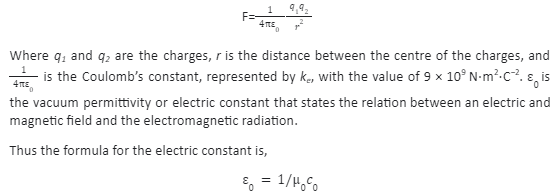Dielectric constant and vacuum permittivity are the two crucial concepts used in the field of electricity. In a circuit of capacitance, the dielectric material is vital to increase capacitance. The dielectric constant measures the ability of the dielectric material to store energy in an electric field. Vacuum permittivity tells us about the capacitance of the capacitor.
Definition of vacuum permittivity
A vacuum is defined as a space that is free from matter. Permittivity is defined as the material’s storage ability to store electrical potential energy under the influence of the electric field. Therefore, vacuum permittivity is defined as the vacuum’s ability to permit the electric field or, in other words, the capacity of the electric field to travel through the vacuum.
It is also called the permittivity of free space, electric constant, or the distributed capacitance of the vacuum.
Formula for vacuum permittivity
Vacuum permittivity gives the relationship between force, length, and electrical charge. The force between the two electrical charges is given by Coulomb’s law which is,

Where,
0 = vacuum permittivity
µ0 = magnetic constant
c0 = speed at which light travels
Value of Vacuum Permittivity
ε0 = 8.8541878128(13)×10−12 F⋅m−1 (farads per metre).
Definition of Dielectric constant
A dielectric material is one that is a poor conductor of electricity. The dielectric constant is also known as the relative permittivity. It is the ratio of the absolute permittivity of a medium to the absolute permittivity of vacuum, and is expressed as:

Where εr is the dielectric constant and ε is the medium’s absolute permittivity.
Absolute permittivity: It is the property of the medium which informs us of the flux density that will be generated at a point due to a certain electric field intensity at a point in that field.
Uses of dielectric material
Capacitor designing
The dielectric constant is used in determining the design of capacitors as well as the capacitance in the circuit. The electric field of the circuit decreases within the dielectric volume if the material with a high dielectric constant is introduced in it. This principle can be used in a capacitor design to increase the capacitance of the circuit.
Telecommunication
Polyethylene is used in coaxial cables as the filler between the centre conductor and outside shield—for example, the transmission cables used in regulating a radio frequency. Dielectrics are used in the form of filters in the waveguides, for example, optical fibres that are set inside waveguides to form filters. Optical fibres that help control the refractive index of the material are purposefully doped dielectric materials with impurities to regulate the value of relative permittivity within the cross-sections.
To obtain the weather information
Relative permittivity changes can be detected using changes happening in the capacitance of the capacitors with the help of sensors. The relative permittivity of air depends on factors such as temperature, humidity, and barometric pressure; a change in any of these leads to changes in relative permittivity, resulting in changes in the capacitor. Temperature and humidity are the major factors responsible for such changes. Pressure tends to be quite stable. Special formulas are used to find out the relative humidity using capacitance and temperature measurement.
Chemistry
It is important to know the relative permittivity of some substances to prepare a sample, design separation, or perform chromatography in analytical chemistry. The solvent has a relative static permittivity equivalent to the measurement of its chemical polarity. Water, which is polar and has the relative static permittivity of 80.10 at the temperature of 20 °C, is different from the relative permittivity of n-hexane, which is non-polar in nature, is 1.89 at the temperature of 20 °C .
Conclusion
Therefore, we can conclude that vacuum permittivity is defined as the vacuum’s ability to permit the electric field or, in other words, the capacity of the electric field to travel through vacuum. In contrast, the dielectric constant is the ratio of the absolute permittivity of a medium to the absolute permittivity of vacuum. The dielectric constant informs us about the electrical storage ability of the insulator. Further, it has various real-life applications. Vacuum permittivity gives us insight into the capacitance of a circuit’s capacitor.
 Profile
Profile Settings
Settings Refer your friends
Refer your friends Sign out
Sign out






